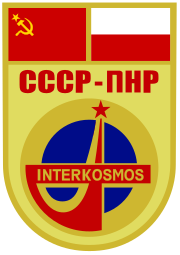Soyuz 30
| COSPAR ID | 1978-065A |
|---|---|
| Mission duration | 7 days, 22 hours, 2 minutes, 59 seconds |
| Orbits completed | 125 |
| Spacecraft properties | |
| Spacecraft type | Soyuz 7K-T/A9 |
| Manufacturer | NPO Energia |
| Launch mass | 6,800 kilograms (15,000 lb) |
| Crew | |
| Crew size | 2 |
| Members |
Pyotr Klimuk Mirosław Hermaszewski |
| Callsign | Кавказ (Kavkaz - "Caucasus") |
| Start of mission | |
| Launch date | 27 June 1978, 15:27:21 UTC |
| Rocket | Soyuz-U |
| Launch site | Baikonur 1/5 |
| End of mission | |
| Landing date | 5 July 1978, 13:30:20 UTC |
| Landing site | 300 kilometres (190 mi) W of Tselinograd |
| Orbital parameters | |
| Reference system | Geocentric |
| Regime | Low Earth |
| Perigee | 197.6 kilometres (122.8 mi) |
| Apogee | 261.3 kilometres (162.4 mi) |
| Inclination | 51.66 degrees |
| Period | 88.83 minutes |
| Docking with Salyut 6 | |
|
Soyuz programme
(Manned missions) |
|
Soyuz 30 (Russian: Союз 30, Union 30) was a 1978 manned Soviet space flight to the Salyut 6 space station. It was the sixth mission to and fifth successful docking at the orbiting facility. The Soyuz 30 crew were the first to visit the long-duration Soyuz 29 resident crew.
Soyuz 30 carried Pyotr Klimuk and Mirosław Hermaszewski, the first Polish cosmonaut, aloft.
The second Intercosmos mission was launched 27 June 1978 to the orbiting Salyut 6 space station. The Soyuz docked with the space station on 29 June, and cosmonauts Klimik and Hermaszewski were greeted by Vladimir Kovalyonok and Aleksandr Ivanchenkov, the resident crew who had been on board for 12 days. For the third time, the Salyut was a four-man orbiting space laboratory.
The activities of the Soyuz 30 crew, however, were severely curtailed so as not to interfere with the Soyuz 29 crew. On the Soyuz 29 crew's rest day, the international crew had to stay in their Soyuz to perform their experiments. Nevertheless, Hermaszewski conducted many experiments. One was crystallization experiments which produced 47 grams of cadmium tellurium mercury semiconductors for use by infra-red detectors on board the station. The yield was far greater - 50% compared to 15% - than ground-based experiments.
...
Wikipedia

